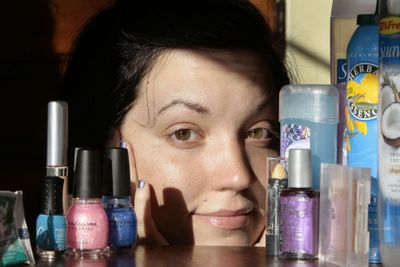Chemicals in personal-care goods draw concern

Now we’re really getting personal. We’re focused on your private place – the bathroom. That’s generally where you use all that soap, body wash, shampoo and lotion. And deodorant, perfume, shaving cream, lip balm, lipstick, mascara, eye shadow, hair gel, mousse, hairspray, anti-aging serum …
It all gets applied to your body, including all of the chemicals within.
Diane MacEachern, author of “Big Green Purse,” suggests a fun little exercise: Gather all those products in one place and take a count. You won’t be alone if the number hits 12 or 15.
“People are amazed,” she says. “Someone has convinced us we need to use all these products every day.”
Eco-groups and environmental researchers have raised alarms about the cumulative health effects of many of the compounds found in personal-care products. While many industry experts say the products are safe, some scientists and others outside the industry disagree.
The health questions boil down to two: What happens to the body after the skin absorbs certain compounds day after day, year after year? What happens to the environment as chemicals from these products are washed down the drain?
Leslie Stullken of Fairway, Kan., had an “aha” moment about two years ago. As a food coach, she helps people prepare meals with local, seasonal and organic food.
She often tells them that “what you eat becomes a chemical message to your body.” In other words, if it’s not a nutrient, it might be a toxin.
“I realized, so what am I doing to my skin?” she says.
Stullken performed her own product count and quickly tallied a dozen items she uses every day. As her existing supplies were depleted, she began switching to products with natural ingredients. The Zum brand from Indigo Wild is among her favorites.
“I can pronounce the ingredients,” Stullken says. “I feel safe and clean. And it’s the sense that I don’t have to worry about what’s in this stuff.”
For Laurie Hughes of Kansas City, Mo., a painful skin condition called “inverse psoriasis” prompted her to question the body products she used.
Hughes underwent a series of steroid treatments to control the psoriasis. Then she began researching manufacturers of natural products. She even attended National Psoriasis Foundation conferences.
Besides avoiding preservatives and other chemicals in personal care products, she has also cut back. Doing her makeup now means mascara and lipstick. That’s all.
“I think it just looks fine, unless someone tells me different,” Hughes says. “And the thing you find out after a while is how much better you feel overall.”
In her book, published this year, MacEachern says women spend 85 cents of every dollar in the marketplace and are predisposed to protect the environment and health.
That puts them in a strong position to force the greening of products, she argues. And in the personal-care category, they’re the target audience.
“The way we spend our money is our first line of defense,” she says. “American women have more economic clout than the GDP of China. It’s huge.”
Emily Main of National Geographic’s Green Guide says many consumers aren’t aware that the Food and Drug Administration doesn’t review the safety of cosmetics and other skin and beauty products, or that many chemicals restricted or prohibited by the European Union aren’t restricted in the United States.
A group called the Cosmetic Ingredient Review panel ( www.cir-safety.org) evaluates safety, but critics point out that it’s funded by the personal-care product industry.
Even so, Main says, consumers seem to be more concerned about broader health effects – that leftover chemicals from soaps, cosmetics and other products are sullying the environment and threatening wildlife and the water supplies.
“I think that’s where people really start to pay attention,” she says.
So how to assess the risk to us and to the environment? The answer may depend on your outlook.
For instance, synthetic preservatives called parabens, widely used in cosmetics and other personal-care products, have shown up in breast cancer tumors. But parabens have been considered safe for years, and there had been no direct link made to breast cancer. Some consumers find assurance in that.
MacEachern prefers the “precautionary principle.” It calls for action against health and environmental risks even if cause-and-effect hasn’t been firmly established. And it demands that the industry bear the burden of proving its products safe.
“You don’t wait till your child gets hit by a car to tell him to look both ways before crossing the street,” MacEachern says.
If you’re concerned, try taking these steps, compiled from recommendations by MacEachern, Main and Kim Erickson, author of “Drop-Dead Gorgeous”:
•As a start, assess the array of personal-care products you use. Are there items you can do without?
Eliminate one, or several, from your daily repertoire and see if you really miss any of them. Plenty of products you use probably have similar purposes.
“This is one place you can save a lot of money,” MacEachern says.
•Another method to reduce the volume of personal-care products: Regularly take a day off.
That means wash up and brush your teeth – whatever you think the minimum is – and don’t slather anything else on your body that day. It could be once a month or once a week.
•Watch for troubling ingredients. Check out labels; there’s some merit in choosing products with the shortest ingredient lists. The more complicated the formulation, the more likely it has lots of synthetic ingredients.
Also, be aware of meaningless terms. Marketing words on the label such as “natural,” “botanical” and even “organic” might mean very little, because no government agency is monitoring their use.
If your favorite products contain ingredients you want to avoid, you’re not stuck. Other companies are responding to demands like yours, with more and more items free of fragrances and parabens, for instance.
A few possibilities include Aubrey Organics, Burt’s Bees, Ecco Bella, Jason, Honeybee Gardens, Miessence, Pangea Organics, Terressentials and Tom’s of Maine, but there are many, many more.